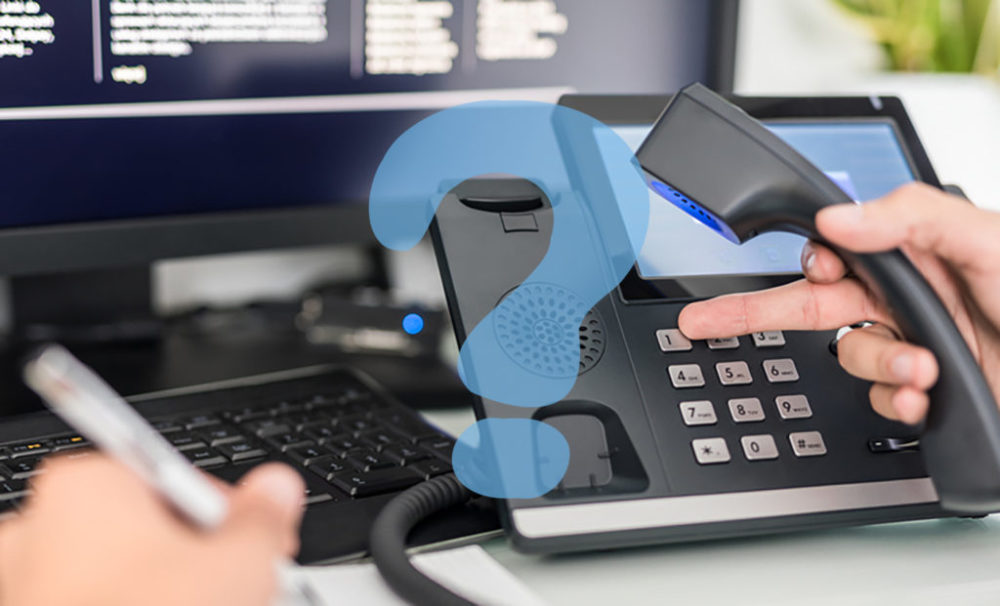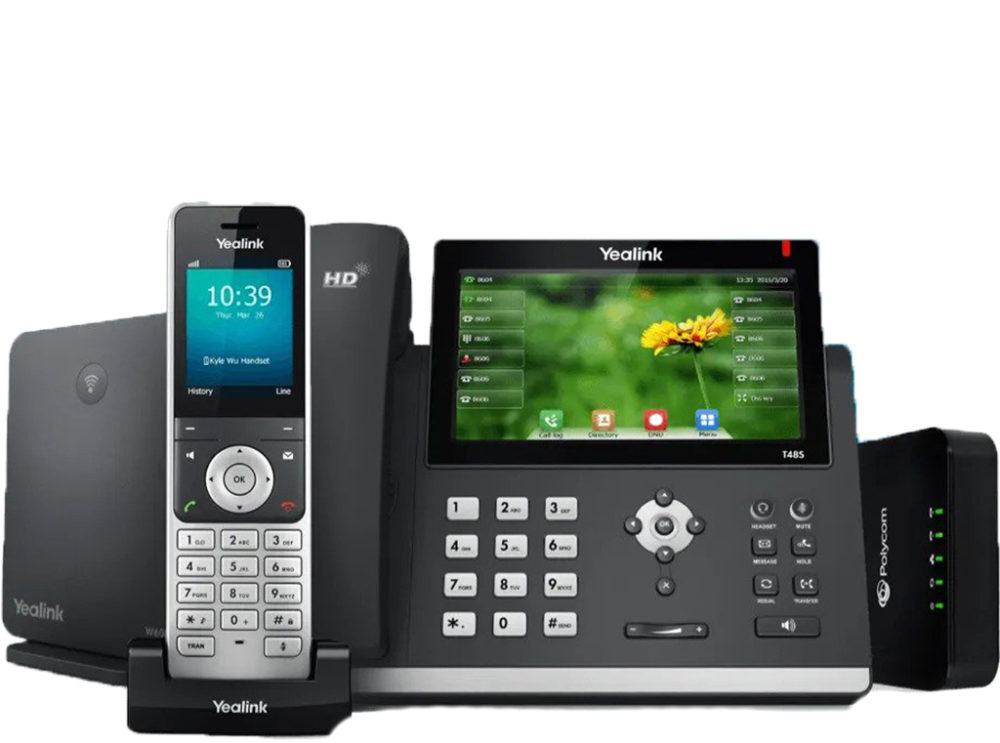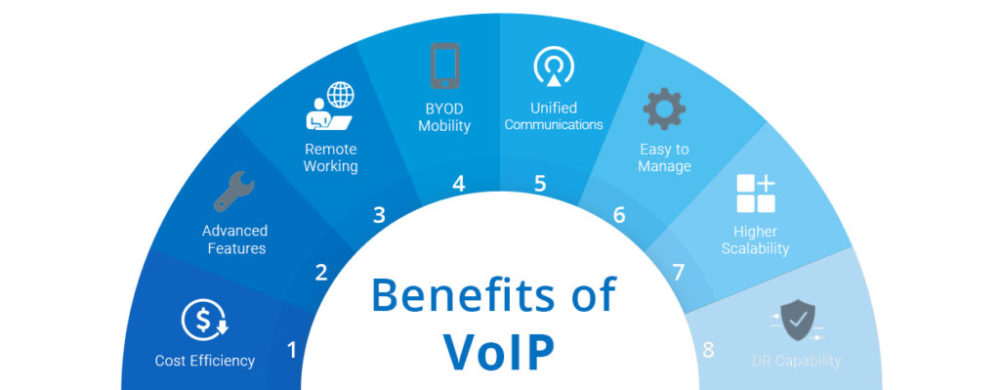As traditional telephone systems, which traditionally set up their connections via the copper cables of the fixed network, have been phased out, VoIP has opened up many new opportunities for telecommunications. However, some potential users are still unsure about this technology and what differences an IP connection brings.
Table of Contents
What is Voice over Internet Protocol?

This interesting picture exudes anger at their Voice over Internet Protocol handset.
VoIP stands for Voice over Internet Protocol and refers to voice communication via Internet-based networks. VoIP thus represents the technical basis of IP telephony. VoIP, IP telephony, and Internet telephony are often used synonymously.
Voice over Internet Protocol refers to transmitting voice data via the Internet instead of using traditional telephone networks (PSTN or ISDN). For this purpose, IP (Internet Protocol), for short, was initially designed only for switching data packets in computer networks. However, as it quickly became the standard, it was adapted to the data packet-based transmission of voice information. It is now possible to communicate via VoIP using a computer, tablet, or smartphone with Internet access.
- Voice over Internet Protocol simplifies telephony processes and enables new functions and services that are difficult or costly to implement in the conventional telephone network:
- Multiple calls can be transmitted simultaneously via a broadband connection. If new IP-based telephone lines are required at any time, they can be easily added without physical installation.
- Features such as call forwarding, caller ID, or automatic redialing, previously only offered by many telephone providers for a fee, are now cheaper and easier to use, thanks to VoIP.
- VoIP technology supports unified communications, enabling the integration of advanced Internet services such as video conferencing, instant messaging, and live website chats.
- VoIP telephone systems in different locations can be linked together, and long-distance calls can be routed through them. This saves money on international calls, billed as local calls, and enables local number display. This promotes trust in customer communications.
Internal calls between different locations and calls to employees on the road or in the home office are free of charge. SIP forking simultaneously allows an extension to be reachable via other devices (desk phone in the office, VoIP app on smartphone, softphone on desktop).
Software-based systems are more easily scalable and flexible than traditional phone systems. They allow new functions and features to be implemented more easily and quickly without purchasing new hardware.
Voice over Internet Protocol also enables features such as hot-desking, which allows automatic provisioning of extensions. Employees working in shifts can thus share one device. This saves office space, reduces purchases and maintenance costs, and optimizes device utilization.
These and many other benefits of VoIP are driving enterprises’ rapid growth of VoIP PBXs.
How Do You Make Calls Using VoIP?
VoIP’s functional principle is always the same – regardless of the technology used. Voice is converted into digital signals using analog-to-digital converters and then sent over the network in individual data packets. Therefore, the following variants differ in the type of terminal device used and the device and time for converting the digital data packets into IP packets.
Here’s what you need to make calls with Voice over Internet Protocol:
- Voice over Internet Protocol server such as 3CX Phone System
- Internet access broadband. Rule of thumb: 100 kbps per direction per call/line minimum.
- VoIP provider or VoIP gateway if you have an analog/ISDN phone line and analog/ISDN phones
- VoIP end devices such as IP phones or integrated softphones:
IP phones, i.e., devices that bring the appropriate technologies to make calls directly over Voice over IP, include VoIP-enabled cell phones. These telephones require a network interface (Ethernet or WLAN) via which IP packets are sent and received.
Softphones, i.e., software that runs on a computer or smartphone and functions as a virtual telephone. Voice input and output are usually enabled via connected speakers/headphones, microphones, USB phones, or headsets. The end device is connected to the network and takes over the “IP packaging.”
VoIP Advantages for Your Company
In the following, we will discuss some benefits of using VoIP technology for businesses. Find out how much potential there is in uniting a wide variety of services under the umbrella of unified communications in a familiar environment.
Easy Installation, Configuration, and Management
A software-based phone system running on-premise on a local server or hosted off-site enables the full power of available hardware, software, and operating systems to be leveraged. While traditional phone systems often have complicated interfaces that vendor experts can only operate, an IP phone system can be easily managed via an intuitive user interface. Any user with basic IT skills can install and configure such a phone system with little effort.
Traditional self-contained systems, on the other hand, often require specially trained technicians to do this. Last but not least, VoIP systems can be even better adapted to your company’s telephony requirements and needs by assigning specific rights for access, use, and configuration to user groups and individual users.
Use of the Existing Network Infrastructure
You can connect phone hardware directly to a standard network port when using a VoIP phone system. This can be shared with the nearest computer. Software telephones can be installed directly on the PC. This means that no separate cabling is required to set up the system. There is also no need for time-consuming maintenance of the telephone system.
You can easily add new extensions thanks to the high flexibility and scalability. Suppose a telephone system is not yet available, for example, in the case of new business premises. In that case, it is possible to install a complete Voice over Internet Protocol telephone system simultaneously and at a low cost by setting up a computer network. Employees can flexibly and easily connect their VoIP phone to any.
Ethernet port and still be reachable under their phone number (ideally supported by push technology). Last but not least, VoIP telephony offers all the benefits of roaming, with calls being effortlessly redirected to any location worldwide thanks to SIP (Session Initiation Protocol).
Flexibility & Scalability
IP phone systems are based on an open standard, the SIP protocol used by all modern VoIP phone systems, giving you vendor independence.
This has the advantage that almost any SIP phone or Voice over Internet Protocol gateway can be used for VoIP communication. With conventional, proprietary telephone systems, on the other hand, optimized or new functions can often only be used by purchasing new expensive hardware or expansion modules.
Moreover, a proprietary PBX system can hardly keep pace with rapid growth: As the number of telephone lines or extensions increases, it is not uncommon for the hardware to have to be expanded at a corresponding cost.
Sometimes even a completely new telephone system is required. Not so with an IP PBX: many telephone lines and extensions can be managed effortlessly, even with a standard computer. If necessary, new telephones are added.
User-friendly Functions for More Service and Productivity.
Because a VoIP PBX is software-based, it’s easier to design, add or optimize new features. Many VoIP systems already come with many features, including automatic answering machines (IVR), voice mail, call waiting, and more. Additional costs often have to be calculated here if these features are desired with proprietary systems. Conference calls are also a convenience that proprietary telephone systems offer with little or no effort and expense.
On the other hand, Integrated softphones offer all functions clearly and easily understandable via a familiar Windows user interface as software-based SIP telephones at no additional cost. By seamlessly integrating telecommunications into the local network, developers can incorporate telephony into data processing and numerous enterprise applications. For example, incoming calls can be answered more quickly because the caller’s account can be accessed immediately by recognizing the caller ID.
This means that the required data is available more quickly, the customer saves valuable waiting time, and work processes can be designed cost-effectively. Outbound calls are made rapidly via directly integrated applications and databases.
Cost Benefits and Control Over System Status and Calls
In many cases, status monitoring of proprietary systems is only possible via expensive, vendor-specific system telephones. But even with this hardware, the system’s status cannot always be clearly and unambiguously determined. VoIP telephone systems allow you to maintain complete control over your telephone system via a web interface and also allow you to specify which users should have access to these monitoring functions.
The connection data of incoming and outgoing calls are stored in a database on the server, so call costs and volume can be analyzed in detail, saved, and shared as a report. Organizations cut high costs using a VoIP provider (SIP trunks), especially long-distance or international calls. A bridge can also connect to additional offices or branches, enabling free internal calls.
VoIP Wrap Up
The introduction of VoIP does not have to change the entire usage behavior. For example, telecommunications technology is characterized by a high degree of backward compatibility. Fax machines, for example, can still be connected to the telephone system via a Voice over Internet Protocol gateway. But an IP PBX offers more flexibility, scalability, features, and, most importantly, lower telephone costs.




Recent Comments